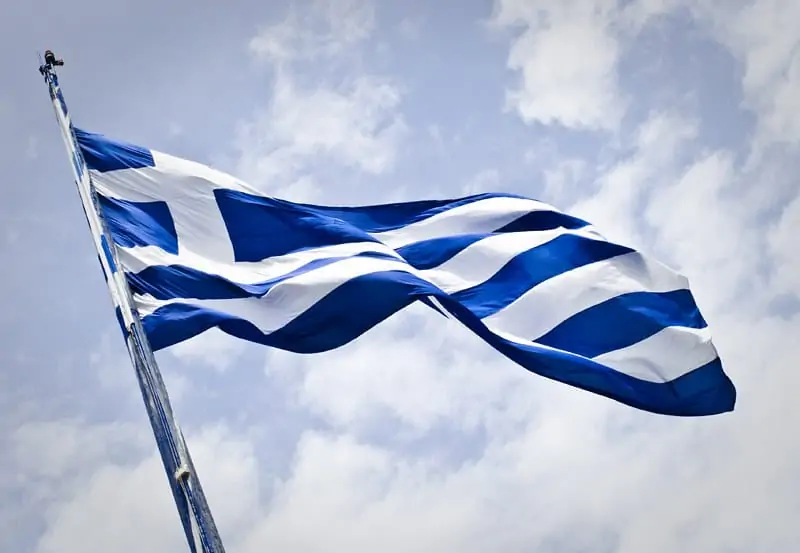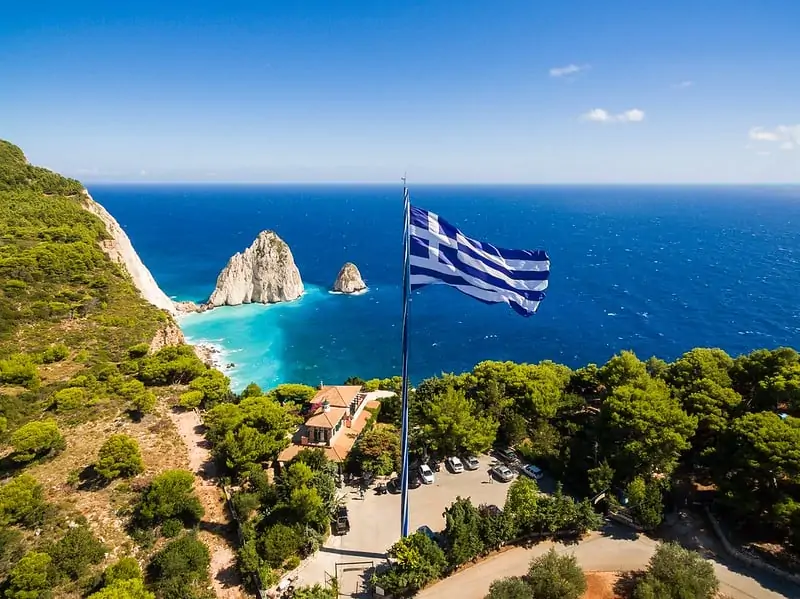The Greek flag, much like the nation it represents, has undergone significant changes throughout its long and turbulent history. During the Ottoman occupation, different regions and even families in Greece had their own distinct flags. After overthrowing Ottoman rule, Greece officially adopted the “Η Γαλανόλευκη” in 1978—translated as “blue and white”—as its national flag. When people look at its colors, they often think of the sky, the sea, or the whitewashed buildings gleaming under the Mediterranean sun. This is just one of many fascinating aspects of the Greek flag, so let’s dive into its story.
About the Greek National Flag
Greece is a country blessed with endless coastlines and a vibrant culture. The Greek flag mirrors its rich heritage and stunning landscapes. Officially, the flag has a 2:3 ratio, featuring a white cross on a blue background in the upper left corner. It consists of nine horizontal stripes—five blue and four white—with blue stripes at the top and bottom, interspersed with white ones in between.
The Meaning Behind the Greek Flag
Every country has its own national flag, a source of pride and identity recognized worldwide. These flags often carry the spirit of a nation, a deep meaning, or a pivotal historical moment. The Greek flag is no exception, so let’s explore what it stands for.
The Nine Stripes of the Greek Flag
As mentioned earlier, the Greek flag features nine stripes. These represent the nine syllables in the Greek phrase “Eleutheria H Thanatos,” which translates to “Freedom or Death.” This was the rallying cry of the Greek Revolution, a final stand against Ottoman oppression.
The Cross on the Greek Flag
The flag bears a cross with equal horizontal and vertical arms in the upper left corner, symbolizing the Greek Orthodox Church—the dominant religion in Greece at the time. The church played a vital role in the fight for independence, advocating for religious freedom and cultural growth. Monks and clergy stood firm, fiercely resisting the brutal Ottoman forces.
The Colors of the Greek Flag
While many national flags burst with vibrant hues, Greece opted for a fresh and subtle palette that’s no less striking. The flag features just two colors: blue, representing the Mediterranean Sea—a cornerstone of the nation’s economy and culture—and white, evoking the waves crashing gently along its shores.
The History of the Greek Flag Through the Ages
In ancient Greece, the idea of a “nation” wasn’t quite what it is today. Still, flags existed as signals or markers of territorial sovereignty. Ancient Greeks etched symbols, letters, and animals onto objects like weapons, shields, and ship masts, laying the groundwork for the flags that would come later.
Flags During the Byzantine and Ottoman Eras
By the Byzantine and medieval periods, flags were widespread across Europe. Emperors, nobles, lords, and rulers used them to mark boundaries or battlefields. In 1453, when Constantinople fell to the Ottoman Empire, the double-headed eagle—a symbol carried over from Roman times—appeared on most flags of the era.
The Greek Flag During the Revolution
The year 1821 marked the start of Greece’s War of Independence against the Ottoman Empire. During this time, various regional flags and symbols emerged. Local leaders crafted their own versions, influenced by personal tastes, historical knowledge, and attachments, though some common threads persisted. The most recurring element was the cross, representing Greek Orthodox Christianity—a faith deeply revered by the majority of the population.
Fascinating Facts About the Greek Flag
- The Greek national flag can only be made in eight specific sizes, though the height-to-width ratio is always 2:3.
- No exact shade of blue is specified in the flag’s design guidelines.
- The flag is raised from 8 a.m. until sunset at public buildings like the Greek Parliament, ministries, embassies, and schools. It’s also used at military barracks, naval ships, and commercial ferries. On certain holidays, it may fly at night.
- The flag must be attached to a pole with precise specifications—it can’t simply hang from a balcony.
Frequently Asked Questions About the Greek Flag
What Should You Keep in Mind When Using the Greek Flag?
The Greek flag isn’t allowed for commercial or advertising purposes, nor can it serve as a banner for companies, associations, or organizations. If a flag becomes worn or torn, it shouldn’t be tossed in the trash—it must be destroyed in a ceremonial fire.
What Did the Greek Flag Look Like Before 1978?
After the Greek Revolution, several versions of the flag existed. These typically featured blue and white, a cross, and sometimes additional symbols.
What Happens If You Deface the Flag in Greece?
A national flag is a sacred and cherished symbol, and disrespecting it is frowned upon anywhere. In Greece, removing, destroying, or defacing the official flag can lead to up to two years in prison or a fine.
As you can see, the Greek flag may not dazzle with bold colors, but it carries a natural, humble beauty. Beneath its simplicity lies a message for future generations: preserve peace, independence, and freedom, and build the nation like the relentless waves of the sea. This small flag holds a vast culture, monumental events, and the spirit of an entire people. Hopefully, this exploration has shed light on the wonders of the Greek flag and answered any questions you might have had.










